Wednesday, 6th December 2023
Decadal Retreat: Glaciers Reduced by 1 Meter Annually
In News: Global Glacier Thinning Averaged 1 Meter Annually from 2011 to 2020 as per WMO report.
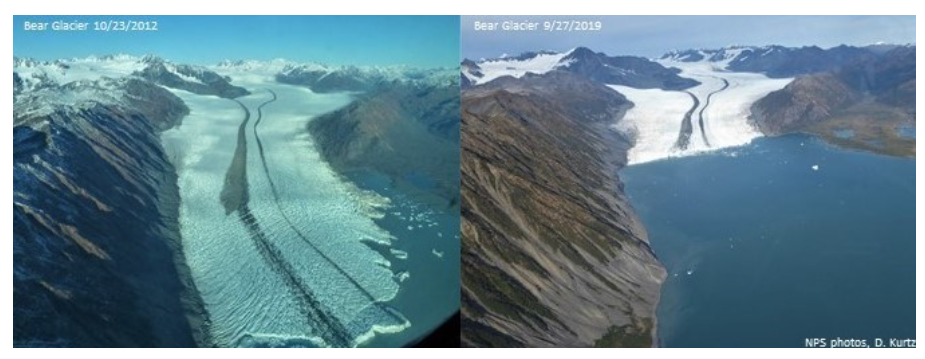
About Glacial Retreat
Glacial retreat pertains to the phenomenon where a glacier diminishes or contracts in size over time due to a reduction in ice accumulation or an escalation in ice melt.
Contributing Factors
- Global Warming and Glacier Dynamics
- The escalating trend of global warming is primarily attributed to the emission of greenhouse gases resulting from the combustion of fossil fuels.
- These gases, responsible for trapping heat in the atmosphere, contribute to the accelerated melting and recession of glaciers as temperatures rise, revealing the underlying land.
- Climate Change Outlook
- Forecasts indicate an imminent peak in glacier loss, directly linked to the rapid melt rate driven by escalating temperatures caused by global warming.
- Human-induced global warming emerges as the predominant factor behind the alarming retreat of glaciers, as substantiated by various studies.
- Impacts of Oil and Gas Extraction
- The extraction of oil and gas introduces methane, a primary component of natural gas, into the atmosphere.
- Methane, possessing a higher heat-trapping efficiency than carbon dioxide, intensifies global warming, exacerbating environmental harm and hastening glacier melt.
- Solar Radiation Influence
- A crucial determinant affecting glacier melting and recession is the quantity of solar energy reaching the ice.
- Increased exposure to radiation leads to accelerated melting, contributing to the loss of glacier mass.
- Role of Glacial Till
- Moving glaciers accumulate an unsorted mass of material known as glacial till, encompassing everything from silt to large boulders.
- This till serves as a protective layer for the ice, shielding it from melting as weaker surrounding ice dissipates.
Consequences
- The repercussions of glacial retreat are far-reaching, encompassing shifts in water availability, modifications to local ecosystems, and heightened susceptibility to natural calamities such as floods and landslides.
- Moreover, the diminishing glacial ice contributes to the escalation of sea levels, exerting substantial impacts on coastal communities and ecosystems worldwide.
- As a result of climate change, human activities, and other environmental factors, glacial retreat has become a prominent indicator of broader ecological transformations.
- Monitoring and understanding these changes are crucial for assessing the health of Earth's cryosphere and comprehending the cascading effects on our planet's climate and biodiversity.
- Efforts to mitigate these impacts often involve global initiatives aimed at addressing climate change and promoting sustainable practices.
Factors Influencing Glacial Dynamics
- A research team from the Wadia Institute of Himalayan Geology in Uttarakhand conducted a comparative study on two glaciers, namely the Pensilungpa Glacier in Ladakh and the Durung-Drung Glacier in Ladakh, spanning the years 1971 to 2019.
- The study's focus was to quantitatively assess the impact of debris cover on the summer loss of ice mass and the terminal recession of glaciers.
- The findings underscore that the rate of glacier retreat is intricately linked to both climate change and the glacier's topographic setting and morphology.
- Moreover, the study revealed that the thickness of the debris cover plays a significant role in influencing how glaciers respond to climate forcing.
- Beyond this, various other factors contribute to the heterogeneous dynamics of glaciers, including snout geometry, glacier size, elevation range, slope, aspect, debris cover, and the presence of supra and proglacial lakes.
- These findings emphasize the multifaceted nature of glacial dynamics, where a combination of climatic, topographic, and morphological factors collectively shapes the behaviour of glaciers over time.
- Understanding these influences is crucial for predicting and comprehending the complex responses of glaciers to environmental changes.
|
UPSC Previous Year Questions Prelims (2016) Q. With reference to the water on Earth, consider the following statements:
Which of the statements given above is/are correct? (a) 1 only Ans: (b) Prelims (2014) Q. Which of the following phenomena might have influenced the evolution of organisms?
Select the correct answer using the code given below: (a) 1 only Ans: c Mains (2021) Q.1 How do the melting of the Arctic ice and glaciers of the Antarctic differently affect the weather patterns and human activities on the Earth? Explain. |
Source: TH
Plastic Pollution - Edukemy Current Affairs
In News: A committee convened in Nairobi in November to draft an international treaty aimed at eliminating plastic pollution.

Global Plastic Pollution: From Origins to Microscopic Impact
- The escalating global production of disposable plastic goods has overwhelmed the world's capacity to manage the resulting plastic pollution.
- While the issue is most noticeable in Asia and Africa, where rubbish collection services are often inadequate, wealthier nations with poor recycling rates also struggle to handle waste plastics.
- The United Nations seeks to address this pervasive problem through the creation of a global convention.
- Although fossil fuel-based plastics have been integral to modern life, constituting life-saving medical devices and enabling technological advancements, they have also given rise to a culture of waste.
- Single-use plastics, comprising 40% of annual plastic production, contribute significantly to pollution.
- Despite being used for only minutes or hours, these items endure in the environment for hundreds of years.
- Plastic waste, primarily originating from land, flows into oceans through major rivers. Once at sea, plastic debris remains in coastal waters, but ocean currents can transport it globally.
- Microplastics, resulting from the breakdown of larger plastic waste, now pervade the water column worldwide, from Mount Everest to the Mariana Trench.
- These tiny particles, including microfibers and nanofibers, are even found in drinking water systems and the air.
- The global challenge lies in addressing the environmental consequences of plastic pollution across diverse regions and ecosystems.
Unveiling the Multifaceted Impact of Plastic Pollution: Wildlife, Human Health, and Gender Dynamics
- Impact on Wildlife
- The consequences on terrestrial, avian, and aquatic wildlife are profound, leading to the death of millions of animals annually.
- Approximately 700 species, including endangered ones, suffer the effects of plastics, with seals, whales, turtles, and other creatures falling victim to entanglements and ingestion.
- Microplastics have infiltrated over 100 aquatic species, potentially posing threats to human food sources.
- Impact on Human Life
- Chemicals such as phthalates, BPA, and PBDE, found in plastics, have drawn scrutiny due to their presence in daily items like food packaging and medical devices.
- These compounds, detected in humans, are known to disrupt the endocrine system, raising concerns about their impact on human health.
- Gendered Impact of Plastic Pollution
- The gender-specific ramifications of plastic pollution are often overlooked. Women, frequently marginalized, play a significant role in combatting plastic's effects.
- Women, both as primary consumers and participants in the unregulated waste industry, face heightened vulnerability.
- The urban informal waste management sector, crucial for recycling, involves a substantial proportion of disadvantaged populations, impacting women and children disproportionately.
- Women's higher consumption of plastic, driven by societal norms and product preferences, accentuates the gendered implications of this environmental crisis.
Navigating Solutions for Plastic Pollution: Strategies and Collaborations for a Sustainable Future
- Addressing the global issue of plastic pollution poses significant challenges, considering the immense cost associated with removing plastics from the environment.
- Consequently, the primary focus has shifted towards preventative measures, emphasizing responsible disposal practices and restricting the initial use of certain plastic products.
- In response to this pressing concern, the Indian government has undertaken ambitious initiatives such as the Swachh Bharat Abhiyan (Clean India Mission), Lifestyle for Environment (promoting mindful consumerism), Plastic Waste Management Rules 2016, and the ban on Single-use Plastics.
- These initiatives form the bedrock of efforts to combat plastic pollution in the country.
- Collaboration on a global scale is essential, and organizations like the United Nations Environment Programme and the United Nations Development Programme could partner with NITI Aayog to conduct comprehensive research.
- This research aims to fill the existing gaps in evidence and better understand the specific challenges, effects, and needs at the intersection of women and the plastics sector.
- To effectively combat the gendered impact of plastic pollution, waste management regulations need enhancement, encompassing improved working conditions, fair wages, access to protective equipment, and healthcare.
- Strengthening partnerships between government programs, such as the Swachh Bharat Mission and the Smart Cities movement, is crucial for a holistic and sustainable approach to mitigating plastic pollution.
|
UPSC Previous Year Questions Prelims (2019) Q. Why is there a great concern about the ‘microbeads’ that are released into environment? (a) They are considered harmful to marine ecosystems. (b) They are considered to cause skin cancer in children. (c) They are small enough to be absorbed by crop plants in irrigated fields. (d) They are often found to be used as food adulterants. Ans: (a) Exp:
|
Source: TH
The Global Positioning System (GPS)
In News: The Global Positioning System (GPS) stands out as one of the few everyday technologies that have brought about a revolutionary impact.
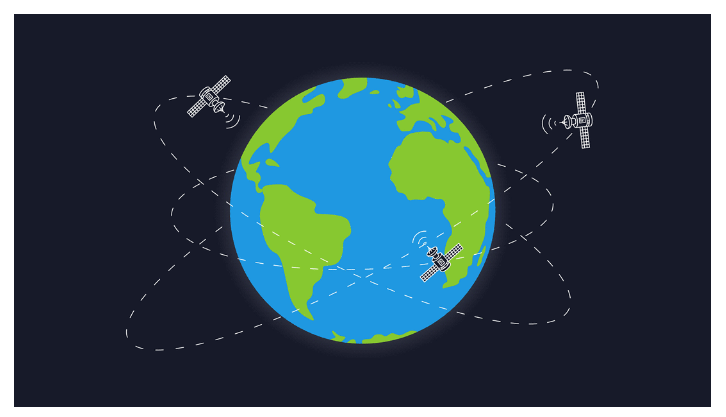
About The Global Positioning System
- The Global Positioning System (GPS) is a navigation system reliant on a constellation of 24 satellites, each completing two orbits around Earth daily.
- Within these orbits, the satellites continuously transmit vital data – comprising the satellite's identifier, spatial coordinates, and the timestamp of transmission.
- GPS receivers capture these signals and leverage the information to compute the precise distance between the receiver and the GPS satellites.
- This technology enables accurate location determination and is widely employed in various applications, including navigation, mapping, surveying, and time synchronization across a diverse range of devices and industries.
Global Navigation Systems: Functions, Applications, and National Initiatives
Navigation and Positioning Applications
- Utilizing signals from three or more satellites, a GPS receiver can pinpoint its ground location, determining longitude and latitude based on known satellite positions.
- With four or more satellites, the receiver can ascertain a three-dimensional position, including elevation.
- Furthermore, GPS receivers can provide real-time data on speed and direction of travel.
- This universal accessibility, offering 24/7 real-time Positioning, navigation, and timing globally, has led to diverse applications such as GIS data collection, surveying, mapping, and more.
National Navigation Initiatives
- India's efforts in establishing its regional navigation system, the Indian Regional Navigation Satellite System (IRNSS), ensure guaranteed access to critical navigation satellite signals.
- The IRNSS constellation, comprising seven satellites, extends accurate navigation signals over India and up to 1,500 km beyond its borders.
- Similar initiatives include America's Global Positioning System (GPS), Russia's Global Navigation Satellite System (GLONASS), Europe's Galileo navigation satellites, and China's BeiDou Navigation Satellite System, aiming for global coverage by 2020.
Reducing Dependence and Ensuring Security
- While the U.S. government currently maintains and provides free access to the GPS system, there is growing recognition of potential vulnerabilities in relying solely on foreign-controlled navigation systems, especially in hostile situations.
- The need for indigenous navigation systems, as demonstrated by India during the Kargil war, underscores the importance of national initiatives to reduce dependence on external sources and enhance security in critical scenarios.
|
UPSC Previous Year Questions Prelims (2018) Q. In which of the following areas can GPS technology be used?
Select the correct answer using the code given below: (a) 1 only (b) 2 and 3 only (c) 1 and 3 only (d) 1, 2 and 3 Ans: (d) |
Source: TH
India's President Backs All-India Judicial Service
In News: The President of India supports the creation of the All-India Judicial Service (AIJS) to enhance diversity in the judiciary.

All India Judicial Service (AIJS): An Overview
- Introduction
- AIJS is a proposed centralized recruitment system designed for judges at the additional district and district levels across all states in India.
- Inspired by the Union Public Service Commission (UPSC) model, AIJS seeks to streamline judge recruitment by centrally assigning successful candidates to different states.
- Historical Roots
- The concept of AIJS traces back to Law Commission reports in 1958 and 1978.
- It resurfaced in 2006 with support from the Parliamentary Standing Committee, aiming to address structural issues such as varying pay, faster vacancy filling, and standardized nationwide training.
- Constitutional Foundation
- Envisioned under Article 312 of the Constitution, AIJS can be established through a Rajya Sabha resolution supported by at least two-thirds of its members.
- However, Article 312 (2) specifies that AIJS cannot include any position inferior to that of a district judge, as outlined in Article 236.
- Purpose and Necessity
- AIJS is envisioned to ensure uniform and high standards in the selection and training of judges, elevating the quality and efficiency of the judiciary.
- It targets the substantial vacancies in lower courts, aiming to enhance representation, diversity, and reduce delays.
- Current Landscape
- Despite its potential benefits, AIJS faces hurdles due to conflicting opinions among major stakeholders.
- As of 2023, the proposal remains unimplemented, underscoring the challenges in achieving consensus for its establishment.
Current Recruitment Process for District Judges
- Existing Mechanism
- Under the current framework, the recruitment of district judges is governed by the provisions of Articles 233 and 234.
- These articles confer authority to the states for the appointment of district judges, with the process overseen by State Public Service Commissions and High Courts.
- High Courts hold jurisdiction over the subordinate judiciary within the state.
- Selection Procedure
- Candidates undergo a comprehensive examination, commonly known as the Provincial Civil Services (Judicial) exam or the judicial services exam, to qualify for judicial roles.
- This examination serves as the primary gateway for individuals aspiring to become judges in the lower judiciary.
- High Court Involvement
- Article 233 specifically addresses the appointment of district judges, emphasizing that the Governor of the State, in consultation with the High Court having jurisdiction over the state, holds the authority to make appointments, postings, and promotions of district judges.
- Article 234 Provision
- Article 234 pertains to the recruitment of individuals other than district judges into the judicial service.
- This article outlines the broader framework for selecting and appointing judges at various levels within the lower judiciary, creating a structured process for judicial appointments.
- Interview Panels
- The selection process typically involves panels of High Court judges conducting interviews with candidates who have successfully cleared the examination.
- These interviews play a crucial role in evaluating the candidates' suitability for appointment to judicial positions.
- Provincial Civil Services (Judicial) Exam
- Referred to as the judicial services exam or PCS (J), it serves as the common entry point for aspiring judges in the lower judiciary.
- Successful candidates in this examination proceed to the interview stage conducted by High Court panels, ultimately determining their appointment to judicial roles.
- Governor's Consultation
- Article 233 underscores the importance of the Governor's consultation with the respective High Court in the appointment, posting, and promotion of district judges, reinforcing the collaborative nature of the selection process.
Concerns Surrounding AIJS Implementation
- Federal Structure and Autonomy
- AIJS raises apprehensions about encroaching upon the federal structure and autonomy granted to states and high courts.
- The constitutional rights of states and high courts to administer the subordinate judiciary might face infringement.
- Dual Control and Conflict of Interest
- The proposal introduces a potential conflict of interest by subjecting judges to dual control, making them accountable to both central and state governments.
- This dual control could pose challenges to the effective functioning of the judiciary.
- Disregard for Local Laws and Customs
- AIJS may overlook the importance of local laws, languages, and customs integral to different states.
- This oversight could hinder the judiciary's effectiveness, as understanding regional nuances is crucial for its proper functioning.
- Impact on Judicial Officers' Morale
- The existing judicial officers may experience a decline in morale and motivation due to perceived limitations in opportunities and incentives for career advancement under the AIJS framework.
Navigating the Path Forward
- Inclusive Dialogues and Consultation
- Initiate comprehensive dialogues and consultations involving states, high courts, and legal experts to address concerns and garner support for AIJS. Inclusive discussions can pave the way for informed decisions.
- Pilot Implementation in Select States
- Consider implementing AIJS on a pilot basis in specific states to assess its impact gradually.
- This phased approach allows for a thorough evaluation and adjustments based on practical experiences.
- Flexible Mechanisms for Adaptation
- Design AIJS with flexible mechanisms that accommodate local laws, languages, and customs.
- Ensuring adaptability to regional nuances is essential for the effective functioning of the judiciary within diverse contexts.
|
UPSC Previous Year Questions Prelims (2021) Q. With reference to the Indian judiciary, consider the following statements:
Which of the statements given above is/are correct? (a) 1 only Ans: (a) Mains (2015) Q. Critically examine the Supreme Court’s judgement on ‘National Judicial Appointments Commission Act, 2014’ with reference to the appointment of judges of higher judiciary in India. |
Source: IE
Mizoram - Edukemy Current Affairs
In News: Inauguration of the New Mizoram Government is Scheduled for December 8th
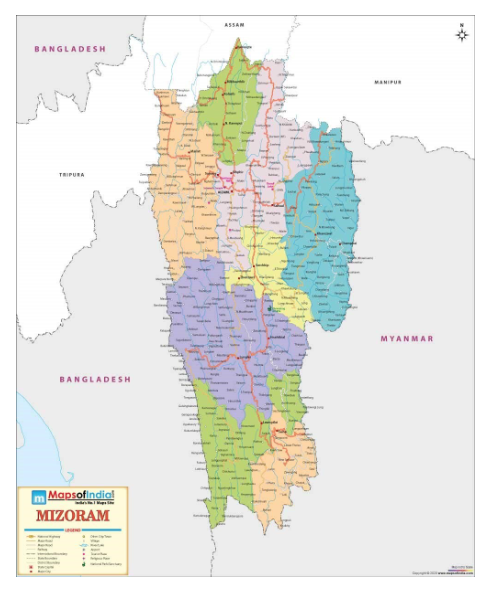
Exploring Mizoram: A Tapestry of Culture, Biodiversity, and Tribal Harmony
- Historical Background
- In the post-independence era, the Mizo hills evolved from being the Lushai Hills district within Assam to the Mizo Hills District of Assam in 1954.
- Mizoram attained Union Territory status in 1972 through an accord with the Mizo National Front (MNF) moderates.
- In 1986, the state emerged from the shadows of the Union Territory, gaining full statehood after signing the Mizoram Peace Accord with the Central government.
- Geographical Overview
- Nestled at the crossroads of Myanmar, Bangladesh, Tripura, Assam, and Manipur, Mizoram paints a vivid picture of cultural and geographical diversity.
- The state shares international borders with Myanmar and Bangladesh and state borders with Tripura, Assam, and Manipur.
- Demography and Literacy
- Mizoram, with an estimated 1.27 million people in 2022, stands as the second least populous state in India after Sikkim.
- The state boasts a commendable sex ratio of 975 females per 1000 males and an impressive literacy rate of 91.58%, surpassing the national average.
- Rich Biodiversity
- According to the India State of Forest Report (ISFR) 2021, Mizoram leads the northeastern region with an astounding 84.53% forest cover of its geographical area.
- The state is home to a diverse array of flora and fauna, with protected areas like Dampa Tiger Reserve, Murlen National Park, Phawngpui National Park, Ngengpui Wildlife Sanctuary, and Tawi Wildlife Sanctuary contributing to its rich biodiversity.
- Cultural Tapestry and Tribals
- Mizoram boasts the highest concentration of tribal population among all Indian states.
- The Mizos, comprising five major and eleven minor tribes collectively known as Awzia, exhibit a close-knit society devoid of class distinctions and discrimination.
- They are primarily agriculturists practicing the 'Jhum Cultivation' or slash-and-burn system.
- Festivals and Dance
- The vibrant cultural landscape of Mizoram is adorned with two main festivals—Mim Kut and Chapchar Kut.
- Mim Kut, celebrated after the maize harvest in August and September, and Chapchar Kut, a lively spring festival, showcase the cultural richness of the Mizos.
- The Cheraw dance, popularly known as the 'Bamboo Dance,' adds a colourful and distinctive touch to their cultural celebrations.
Source: TH
Kenya's Geographical Tapestry - Edukemy Current Affairs
In News: India Extends $250 Million Line of Credit to Kenya for Advancing Agricultural Modernization
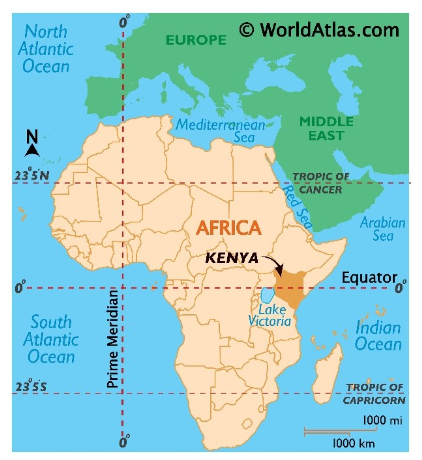
Exploring Kenya: A Tapestry of Geography, Culture, and Human Origins
- Geographical Overview
- Situated in East Africa, Kenya boasts diverse terrain that ranges from a low coastal plain along the Indian Ocean to elevated mountains and plateaus at its centre.
- This geographical diversity has played a pivotal role in shaping the country's landscape and culture.
- Crossroads of Trade and Travel
- Positioned strategically between the Indian Ocean and Lake Victoria, Kenya has served as a crossroads for people traversing and trading from across Africa and the Middle East for centuries.
- This unique location has fostered a rich and diverse culture characterized by various ethnic groups and languages.
- Cradle of Humanity
- Scientists hypothesize that Northern Kenya and Tanzania may be the original birthplace of humans.
- Notably, Kenya's Turkana Basin has yielded significant archaeological finds, including the bones of one of the earliest human ancestors ever discovered.
- Lake Turkana and the Omo-Turkana Basin
- Lake Turkana, recognized as the world's largest desert lake, is part of the expansive Omo-Turkana basin.
- Encompassing four countries—Ethiopia, Kenya, South Sudan, and Uganda—this basin has been a vital geographical feature influencing the region's ecology and human history.
- UN-Habitat Headquarters
- Kenya hosts the headquarters of UN-Habitat at the United Nations Office in Nairobi.
- This international presence underscores Kenya's significance as a hub for global cooperation and urban development initiatives.
Source: TH
National Organ and Tissue Transplantation Organisation (NOTTO)
In News: Indraprastha Apollo Hospital allegedly involved in a 'cash for kidney' racket, enticing impoverished individuals from Myanmar to sell organs for profit.

About National Organ and Tissue Transplantation Organisation (NOTTO)
- The National Organ and Tissue Transplant Organization (NOTTO) operates under the Directorate General of Health Services, Ministry of Health and Family Welfare, with its headquarters situated in New Delhi.
- Within NOTTO, the National Network division serves as the central hub overseeing comprehensive nationwide initiatives related to the procurement, distribution, and registry of organs and tissues for donation and transplantation.
- This division plays a pivotal role in coordinating and streamlining organ transplantation activities across the country.
- NOTTO serves as a crucial entity in the healthcare landscape, fostering collaboration and synergy among various stakeholders involved in organ and tissue donation and transplantation.
- It acts as a catalyst for policy formulation, capacity building, and the implementation of best practices to ensure a robust and efficient organ transplant ecosystem in India.
- The organization is committed to raising awareness about organ donation, promoting ethical practices, and establishing a transparent and accountable system for organ and tissue allocation.
- Additionally, NOTTO actively engages in research, data collection, and analysis to contribute valuable insights to the field of organ transplantation, ultimately enhancing the overall healthcare infrastructure and improving outcomes for patients in need of life-saving transplants.
Source: TH
Mount Merapi - Edukemy Current Affairs
In News: 23 climbers presumed dead as more bodies recovered from Mount Merapi volcanic eruption site
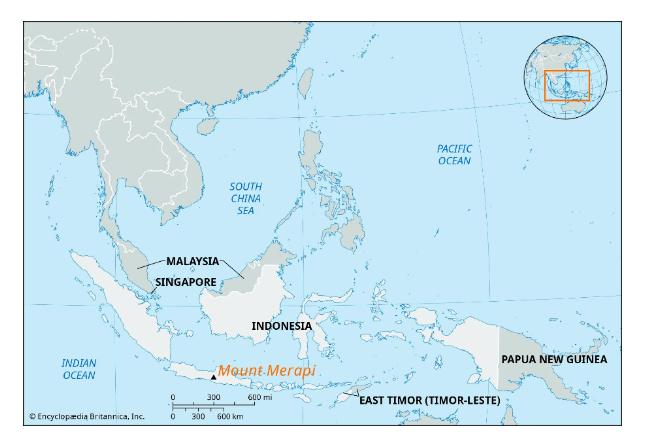
Mount Merapi: A Dynamic Volcano in Indonesia
- Mount Merapi, known as the "Mountain of Fire," stands as one of the planet's most active volcanoes, soaring to an elevation of 9,551 feet.
- With its steep slopes adorned in dense vegetation, it encapsulates the geological dynamism that characterizes Indonesia.
Why Indonesia Hosts Numerous Volcanoes: Unveiling the Ring of Fire's Secrets
- Indonesia, nestled within the expansive Ring of Fire encircling the Pacific Ocean, boasts a remarkable archipelago of over 17,000 islands and islets, harbouring nearly 130 active volcanoes.
- The Ring of Fire, or Circum-Pacific Belt, delineates a path marked by frequent earthquakes and active volcanoes, setting the stage for Indonesia's volcanic abundance.
- Tectonic Plates in Motion: The Catalyst for Volcanic Activity
- The geological phenomenon driving Indonesia's prolific volcanic activity lies in the intense movement of tectonic plates in the region.
- At convergent boundaries along much of the Ring of Fire, subduction zones emerge, where one tectonic plate is pushed beneath another.
- As the lower plate undergoes subduction, it melts into magma, creating a reservoir of molten rock beneath the Earth's surface.
- Transforming Boundaries: Earth's Dynamic Interplay
- A significant exception within the Ring of Fire is the boundary between the Pacific and North American Plates.
- This stretch represents a transform boundary, characterized by lateral movement where plates slide past each other.
- This unique interaction generates a plethora of earthquakes, as accumulated tension in the Earth's crust finds release.
Source: TH
Nigeria - Edukemy Current Affairs
In News: Nigerian Army's 'Mistaken' Drone Attack Results in at Least 85 Confirmed Deaths, Prompting Concerns About Such Errors
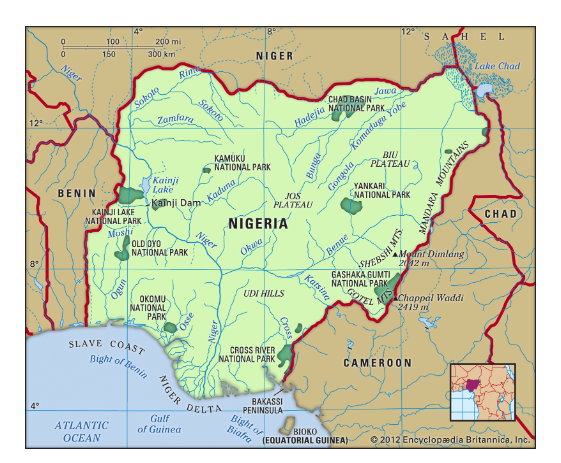
Nigeria: A Nation of Diversity, Economic Strength, and Mineral Wealth
- Nigeria, officially recognized as the Federal Republic of Nigeria, is a West African country positioned geographically between the Sahel in the north and the Gulf of Guinea in the south, along the Atlantic Ocean.
- As the most populous nation on the African continent and the seventh-most populous globally, Nigeria shares borders with Niger to the north, Chad to the northeast, Cameroon to the east, and Benin to the west.
- With over 250 ethnic groups communicating in 500 distinct languages, Nigeria is a diverse nation.
- The three predominant ethnic groups are the Hausa in the north, Yoruba in the west, and Igbo in the east.
- English serves as the official language.
- Recognized as both a regional power in Africa and an emerging global force, Nigeria boasts the largest economy on the African continent. Renowned as the twelfth-largest petroleum producer globally, petroleum contributes significantly, constituting 40% of the GDP and 80% of government earnings.
- Additionally, Nigeria possesses substantial untapped mineral resources, including coal, bauxite, tantalite, gold, tin, iron ore, limestone, niobium, lead, and zinc.
- Despite these abundant resources, the mining industry in Nigeria remains underdeveloped.
Source: TH
Purchasing Managers Index (PMI)
In News: India's Services Purchasing Managers' Index (PMI) hits a one-year low of 56.9, attributed to decreased demand.
Understanding the Purchasing Managers Index (PMI): A Key Economic Indicator
The Purchasing Managers Index (PMI) is a survey-based metric designed to gauge respondents' perceptions of key business variables in comparison to the previous month. Serving as a valuable tool for decision-makers, analysts, and investors, the PMI provides insights into current and future business conditions.
Key Features of PMI
- Calculation and Sectors -The PMI is separately calculated for the manufacturing and services sectors, culminating in a composite index. The resulting figure, ranging from 0 to 100, signifies the health of these sectors.
- Expansion and Contraction - A PMI above 50 signifies expansion, while a score below 50 indicates contraction. A reading at 50 suggests stability with no significant change.
- Economic Indicator - Released monthly, the PMI is a leading indicator of economic activity, offering timely insights into the economic landscape.
- Global Compilation - IHS Markit compiles PMI data for over 40 economies worldwide. As a prominent player in information and analytics, IHS Markit is part of S&P Global.
Significance of PMI
- Indicator of Economic Health
- The PMI is closely monitored due to its direct correlation with the manufacturing and services sectors, pivotal drivers of economic growth.
- Positive and Negative Signals
- A high PMI reading is viewed positively, indicating robust performance in the manufacturing and services sectors, contributing to overall economic growth.
- Conversely, a low PMI reading is perceived negatively, signalling challenges in these sectors that may impact the broader economic landscape.
|
UPSC Previous Year Questions Prelims (2008) Q. What does S & P 500 relate to? (a) Supercomputer Ans: (d) Exp:
|
Source: TH
Revealing Reality: Assessing Renewable Energy Pledges
In News: There is Reluctance of Leading Global Economies to Transition from Fossil Fuels.
Global Dynamics of Fossil Fuel Production and Consumption
- According to the International Energy Agency (IEA), the collective processes involved in fossil fuel production, transportation, and processing led to the emission of approximately 5.1 billion tonnes of CO2 in 2022.
- This accounted for nearly 15% of the total greenhouse gas emissions related to global energy activities.
- Additionally, this sector stands out as a significant source of methane emissions, contributing substantially to both climate change and air pollution.
Emission Reduction Goals
- In alignment with the IEA’s Net Zero by 2050 (NZE) scenario, there is a pressing need to reduce the emissions intensity of fossil fuel activities by approximately half by the close of this decade.
- This ambitious target aims for an overall 60% reduction in emissions from fossil fuel operations.
Major Players
- In 2022, key players in fossil fuel production included the United States, Saudi Arabia, Russia, Canada, and China.
- The OPEC alliance continued to exert influence as a formidable consortium of oil-producing nations.
- Notably, the United States claimed the top position as the world's primary producer of petroleum liquids, contributing a substantial 20% to global production.
Consumption Trends
- The leading consumers of fossil fuels in 2022 were the United States, China, India, Russia, Japan, Saudi Arabia, Brazil, South Korea, Canada, and Germany.
- These nations play pivotal roles in shaping the global landscape of fossil fuel consumption.
India’s Role in the Fossil Fuel Equation
- Current Dynamics
- India, ranking as the world's third-largest consumer of oil, remains deeply entrenched in industrial activities reliant on fossil fuels, with a daily consumption rate of around 5 million barrels.
- Notably, India's annual growth rate in oil demand hovers between 3-4%.
- Import Dependency Shifts
- India's import dependence on both oil and natural gas has witnessed a significant surge.
- The net import dependency for natural gas rose from just over 30% in 2012-13 to nearly 48% in 2021-22.
- A parallel trend is observed in crude oil imports, underlining an increasing external reliance.
Why Countries Hesitate to Restrict Fossil Fuel Production
- Economic Imperatives
- Fossil fuel production, encompassing oil and natural gas, often stands as a linchpin in a country's economic framework.
- It contributes substantially to government revenues, generates employment, and fuels overall economic expansion.
- Energy Security Concerns
- Essential for energy security, oil and natural gas are pivotal to ensuring a consistent and dependable energy supply.
- Countries prioritize increased production to meet domestic demand, fostering self-reliance and mitigating reliance on imports.
- Geopolitical Leverage
- Some nations strategically utilize energy production as a geopolitical tool, leveraging it to exert influence over other nations.
- This geopolitical dimension can complicate international efforts to control and restrict fossil fuel production.
- Domestic Political Dynamics
- Production decisions are intricately linked to domestic political considerations.
- Governments face challenges from diverse stakeholders, including industry groups, local communities, and political factions, influencing the complexities of production control efforts.
Strategies to Reduce Fossil Fuel Dependency
- Concrete Targets
- Developed nations, particularly those with significant resources, must take the lead by setting clear phase-out dates for all fossil fuel production.
- The elimination of new oil and gas investments is a critical step that requires urgent attention.
- Renewable Energy Innovation
- Countries should channel investments into research and development to accelerate advancements in renewable energy technologies.
- This includes funding for breakthrough innovations like next-generation solar panels, advanced wind turbines, and energy storage solutions.
- International Collaboration
- Global collaboration is essential, with countries joining forces in research, knowledge sharing, and collaborative initiatives.
- By pooling resources and sharing best practices, nations can expedite the development of innovative solutions for reducing fossil fuel consumption.
- Aid for Capacity Building
- Developed countries should extend support to developing nations in building their capacity for sustainable energy projects.
- Technical assistance, training programs, and knowledge sharing are vital components in fostering global energy sustainability.
- Green Industrialization
- Promoting the growth of green industries, such as renewable energy manufacturing, is crucial.
- This approach not only creates local job opportunities but also enhances energy self-sufficiency and reduces dependence on fossil fuel imports.
|
UPSC Previous Year Questions Prelims (2020) Q. With reference to furnace oil, consider the following statements:
Which of the statements given above are correct? (a) 1 and 2 only Ans: (d) Q.2 The term ‘West Texas Intermediate’, sometimes found in news, refers to a grade of (a) Crude oil Ans: (a) Mains (2017) Q. The question of India’s Energy Security constitutes the most important part of India’s economic progress. Analyse India’s energy policy cooperation with West Asian countries. |
Source: TH
Share the article
Edukemy’s Current Affairs Quiz is published with multiple choice questions for UPSC exams
MCQ
Get Latest Updates on Offers, Event dates, and free Mentorship sessions.

Get in touch with our Expert Academic Counsellors 👋
FAQs
UPSC Daily Current Affairs focuses on learning current events on a daily basis. An aspirant needs to study regular and updated information about current events, news, and relevant topics that are important for UPSC aspirants. It covers national and international affairs, government policies, socio-economic issues, science and technology advancements, and more.
UPSC Daily Current Affairs provides aspirants with a concise and comprehensive overview of the latest happenings and developments across various fields. It helps aspirants stay updated with current affairs and provides them with valuable insights and analysis, which are essential for answering questions in the UPSC examinations. It enhances their knowledge, analytical skills, and ability to connect current affairs with the UPSC syllabus.
UPSC Daily Current Affairs covers a wide range of topics, including politics, economics, science and technology, environment, social issues, governance, international relations, and more. It offers news summaries, in-depth analyses, editorials, opinion pieces, and relevant study materials. It also provides practice questions and quizzes to help aspirants test their understanding of current affairs.
Edukemy's UPSC Daily Current Affairs can be accessed through:
- UPSC Daily Current Affairs can be accessed through Current Affairs tab at the top of the Main Page of Edukemy.
- Edukemy Mobile app: The Daily Current Affairs can also be access through Edukemy Mobile App.
- Social media: Follow Edukemy’s official social media accounts or pages that provide UPSC Daily Current Affairs updates, including Facebook, Twitter, or Telegram channels.





